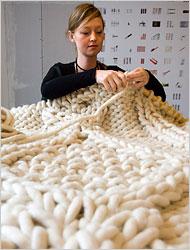From the Series
Christien Meindertsma’s designs blur the line between production and product. The Rotterdam-based designer’s work is a vehicle to make the invisible processes behind her products visible.
“I specialise in the process of how things are made,” she says in this exclusive video interview with Design Indaba. “It’s interesting to make processes transparent, so I try to incorporate my way of working into still existing industries because I really believe in local production.”
She became interested in the flax industry in the Netherlands in 2009 when she created a collection of products for Thomas Eyck, in collaboration with traditional ropemaker Touwslagerij Steenbergen and woodworkers Kuperus & Gardenier.
The Netherlands was a major producer of flax but nowadays it is farmed in smaller quantities with the vast majority exported to China and India for processing, she says.
Like her Pig 05049 project that researched the many different products made from a single pig (including heart valves, ammunition, chewing gum, bio diesel and porcelain), the Flax Project investigates the complete life cycle of flax from seed to rope (used in hanging lights, mats and even an ottoman) and yarn (used in tablecloths).
But Meindertsma took her commitment to production one step further: When the flax farm she was working with received a sales offer from a Chinese buyer, she bought the whole plot.
I am now the happy owner of 10 000 kilos of flax, she says.
With filmmaker Roel van Tour she is documenting all the steps in flax production as the seeds are planted, grown, harvested and processed.
Meindertsma’s interest in asking what lies beneath the systems and processes society takes for granted dates back to her days as a student at Design Academy Eindhoven. Her graduation project, Checked Baggage, collected the hundreds of items confiscated by Schiphol Airport security over one week post-9/11, labeling them carefully and collating them into a book.
“I felt that a lot of these security measures were a fake way of making us safe,” she says. Her book “was a way of showing the seriousness but also the powerlessness of securing everyone”.
In 2012, the Dutch designer was asked by Museum Rotterdam and visual arts studio Wandschappen to create something new out of a collection of 500 sweaters knitted by Rotterdam resident Loes Veenstra. The sweaters, which she began knitting in 1955, had been stored in cardboard boxes in her home.
“The sweaters were never worn, which I thought was a tragedy,” says Meindertsma.
Organising them by yarn colour and pattern, she cataloged them in a series of beautiful photographs. Veenstra was celebrated in a massive street festival that included a group of serenaders, a marching band and a dance troupe – all wearing her sweaters. The street festival was captured in this uplifting film.
In Meindertsma’s view, the process is so inherently a part of product design, that she doesn’t define herself as a “social designer”.
“I think designing a product should make sense for whatever lies behind the product – the crops, the animals, the people making it,” she notes. “For me it's logical that product design is social.”









